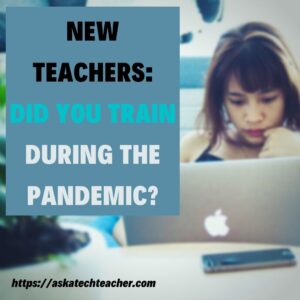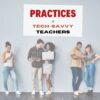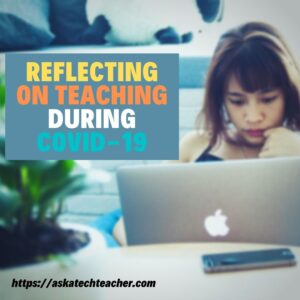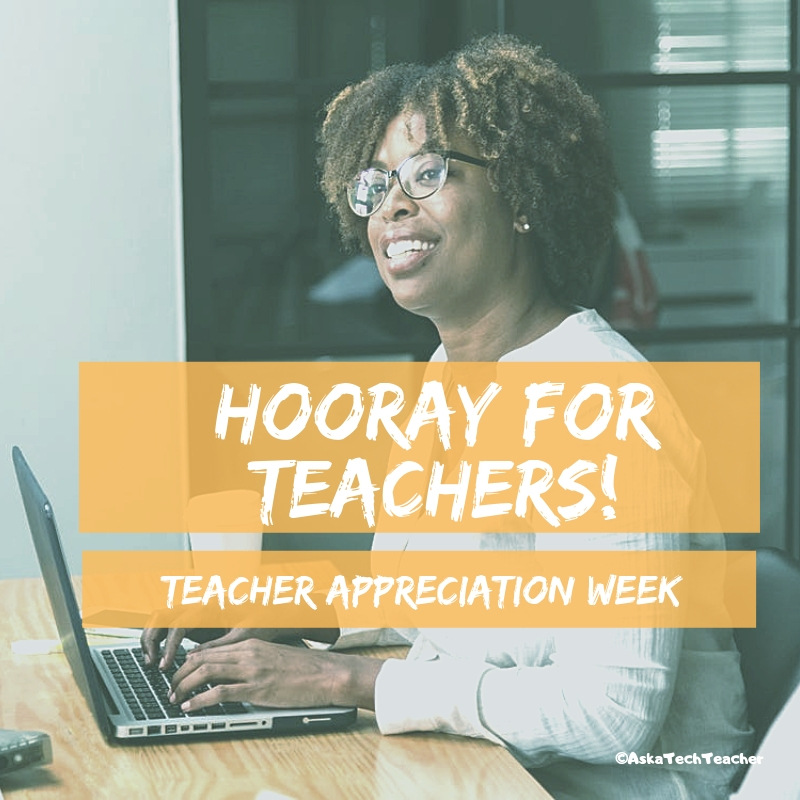
Category: Teaching
Practices of Tech-savvy Teachers
Are you struggling with all the tech required for remote and hybrid teaching? Education Week shares what tech-savvy educators are using to make this work:
5 Practices of Truly Tech-Savvy Teachers
 Education Week caught up with select teachers and instructional coaches who shared their thoughts on some essential practices to effectively implement technology into the practice of teaching. Some were discovered or honed during the pandemic. All offer lessons for job seekers wanting to present in-demand knowledge and skills, as well as districts and schools that are seeking truly tech-savvy teachers.
Education Week caught up with select teachers and instructional coaches who shared their thoughts on some essential practices to effectively implement technology into the practice of teaching. Some were discovered or honed during the pandemic. All offer lessons for job seekers wanting to present in-demand knowledge and skills, as well as districts and schools that are seeking truly tech-savvy teachers.
Ask a Tech Teacher has reviewed a list of easy-to-use, intuitive tech tools we think will make your teaching job easier. Check otu these articles:
How to Evaluate Programs You’ve Never Used in Less Than Seven Minutes
Share this:
New Teachers–From Pandemic to the Classroom
 This is a great article for new teachers who might not have seen the traditional classroom experience. One teacher offers tips to help new starters who did their training in lockdown to feel at home in their classroom:
This is a great article for new teachers who might not have seen the traditional classroom experience. One teacher offers tips to help new starters who did their training in lockdown to feel at home in their classroom:
New Teachers: 10 Ways to Claim Your Classroom Space
The first terms as an early career teacher are daunting: and it can be a while until you feel completely settled in your new role. But your classroom is the place you’ll spend the majority of your time, and it’s crucial that you feel ownership of it, as well as at home within it.
Many of you will have carried out a lot of your teacher training remotely – and therefore, may feel a little uncertain about how to claim classrooms as your own. Here’s my advice.
Here’s more advice for new teachers from Ask a Tech Teacher:
6 Tech Best Practices for New Teachers
New Tech Teacher? I Understand You
Technology and Teaching: A Conversation with Teachers
13 Tips for New Tech Teachers You Don’t Want to Miss

Jacqui Murray has been teaching K-18 technology for 30 years. She is the editor/author of over a hundred tech ed resources including a K-12 technology curriculum, K-8 keyboard curriculum, K-8 Digital Citizenship curriculum. She is an adjunct professor in tech ed, Master Teacher, webmaster for four blogs, an Amazon Vine Voice, CSTA presentation reviewer, freelance journalist on tech ed topics, and author of the tech thrillers, To Hunt a Sub and Twenty-four Days. You can find her resources at Structured Learning.
Share this:
Do you need a career coach?
Now more than ever, teachers are struggling with more questions about teaching than they can find answers for. Let’s start with those you may have about running your classroom. Maybe your school doesn’t offer mentors that will answer these on a daily basis. Maybe you’re new and don’t want to appear too new–or you’re experienced but not in some of the new teaching techniques. Does these sound like questions you have:
 How do you start kindergartners who don’t know what ‘enter’, ‘spacebar’, ‘click’ or any of those other techie words mean?
How do you start kindergartners who don’t know what ‘enter’, ‘spacebar’, ‘click’ or any of those other techie words mean?- How do you teach kindergartners to use the mouse? First graders to keyboard? Third graders to safely search the internet?
- What do you do with students who join your class and haven’t had formal technology classes before?
- You’ve been thrown into the technology teacher position and you’ve never done it before. How do you start? What do you introduce when?
- You’ve been teaching for twenty years, but now your Principal wants technology integrated into your classroom. Where do you start?
- How do you differentiate instruction between student geeks and students who wonder what the right mouse button is for?
- How do you create a Technology Use Plan for your school?
- How do you create a Curriculum Map?
- As an edtech professional, what’s your career path?
- How do you create lesson plans, teach to specific standards, or integrate tech into core classroom time?
I know from my network that teachers are struggling with the massive changes occurring in education. They wonder if they’ve burned out on what once was their passion. Should they keep trying or make changes?
If any of this applies to you, don’t feel you have to handle it alone. Consider a career coach. Check out these resources from colleagues:
Or feel free to contact me. My path may be like yours. I started teaching in a classroom, switched to online classes and then grad school classes. Now, I teach, coach, mentor, and write about education for a variety of ezines and ed companies. I’d love to talk to you about what you’re going through.
Share this:
Technology and Teaching: A Conversation with Teachers
Ask a Tech Teacher contributor, Christian Miraglia, taught for 36 years before retiring. Here is Part 2 of his discussion on technology’s place in education:
Part II Technology is Here to Stay: A Conversation with Teachers
 In my previous post, I wrote about the permanency of technology in the instructional setting for educators. Over the past weeks, I have spoken to a few educators about what has changed for them in this area. There is no doubt that the use of tech tools beyond the general record-keeping for attendance and grading has now found a footing in most classrooms around the nation. Some teachers who were initially hesitant to jump into the depths of technology integration find themselves fully immersed. Some who were on the proverbial edge of the diving board have been pushed into the pool and some have embraced the change with the excitement of a child playing with a new toy.
In my previous post, I wrote about the permanency of technology in the instructional setting for educators. Over the past weeks, I have spoken to a few educators about what has changed for them in this area. There is no doubt that the use of tech tools beyond the general record-keeping for attendance and grading has now found a footing in most classrooms around the nation. Some teachers who were initially hesitant to jump into the depths of technology integration find themselves fully immersed. Some who were on the proverbial edge of the diving board have been pushed into the pool and some have embraced the change with the excitement of a child playing with a new toy.
I recently spoke with a fellow history teacher who has embraced the technology and been quite creative in the process. With a focus on the social-emotional component of instruction, he utilized a master Google Slide deck coupled with one of the Eduprotocols skills such as Number Mania or Iron Chef and the content he was covering. This procedure allowed him to see all of his students responding to the prompt and kept him connected to the students throughout the year. Taking the learning to another level as well as incorporating the 21st Century skill of communication, his students showed their parents an exhibit using Flipgrid they had built based on the unit essential question. Without the use of this recording tool, the work would have been relegated to the school’s LMS as a click-through for the teacher. Moreover, with the exhibit being published, the student’s parents now had validation of their child’s work. Very powerful indeed.
Another teacher found that utilizing an IDE (Integrated Development Environment) that was cloud-based gave her students round-the-clock access to work in their programming class instead of relying on a downloaded file to a school computer. In our current environment, this addresses the issue of student access to content extending beyond the limitations to work only done in between walls of the classrooms.
In another conversation with a colleague of mine who is also a history teacher at the high school level, it was pointed out that because students were just glad to be back in a classroom setting they embraced any assignment that he pushed out. Because of the social distancing mandate in his district, it was important that he be strategic in his instructional strategy. In the previous year of pandemic instruction, he explored how discussion panels could be used specifically using Canvas. He found that students were inclined to post well-thought responses as they looked forward to the feedback from their peers. The same collaborative approach was taken once students returned back to school in the summer utilizing the Eduprotocols. Once school started a couple of weeks ago with limitations on classroom movement students were able to collaborate on Google slides and communicate with each other by using the same strategy. More importantly, after students collaborated they had to report out on their choices. The selection of the strategy and technology tool was very intentional to create a more engaging environment as well as providing for a platform for the students learning experience.
Share this:
Technology is Here to Stay: Now What?
Ask a Tech Teacher contributor, Christian Miraglia, taught for 36 years before retiring. He has some interesting reflections on technology’s place in education:
***
 Remember the days of Oregon Trail on the old Apple IIe’s or students drawing pictures with Kid Pix. Much has changed since technology has made inroads into education, and much has not. I recently retired from public school teaching after thirty-six years as both a US History teacher and TOSA. I dedicated much of my career to finding the appropriate role of technology in the classroom. Although the pedagogy of utilizing technology was not readily available in the early 1990s for educators, it is ever-present today. Companies with a vested interest in their products publish studies touting their applications. I tend to favor independent studies on technology use which take a more balanced approach. However, one thing seems to be lacking: the input of users who will integrate these products in their daily lessons.
Remember the days of Oregon Trail on the old Apple IIe’s or students drawing pictures with Kid Pix. Much has changed since technology has made inroads into education, and much has not. I recently retired from public school teaching after thirty-six years as both a US History teacher and TOSA. I dedicated much of my career to finding the appropriate role of technology in the classroom. Although the pedagogy of utilizing technology was not readily available in the early 1990s for educators, it is ever-present today. Companies with a vested interest in their products publish studies touting their applications. I tend to favor independent studies on technology use which take a more balanced approach. However, one thing seems to be lacking: the input of users who will integrate these products in their daily lessons.
Those first years of the excitement of having a computer for one class in which students would perform of what we would consider a primitive use of gaming seemed so distant. Many platforms offer a more advanced gaming process that builds student vocabulary or is more engaging today. Edudadoo, Endless Alphabet, Spelling City are just a few. Applications on readily available for Chromebooks, IOS, and Microsoft platforms. Integrations into delivery platforms abound. The ongoing debate on whether to use Pear Deck or NearPod is one that I am familiar with. The question arises, “How does one know if the applications have an impact on student learning?”
My approach was to pilot any software application, if possible, for at least 90 days. Most companies offer such opportunities. Although not a data scientist, I documented how the students interacted with the platform. Typically students enjoyed the novelty of something new and exciting, especially if the tools allowed them to become more than passive participants. However, I made sure that students understood that this was a new integration, and it was vital for them to provide feedback on the platform. I remember one particular platform a couple of years ago that had a draw option. Being integrated into my delivery platform, and the students asked if I could incorporate it daily. I had to consider whether the function was more of a distraction because they could spend time drawing or representing learning ideas in my history classroom. After at least 30 days of usage, I concluded that the platform had some perks that enhanced student learning. Not only was I involved in the process, but I utilized student input via a brief survey. Student agency can occur at any level of instruction, including technology integration.
Share this:
A Year to Remember, A Year to Reflect: Pandemic Instruction
Ask a Tech Teacher contributor, Christian Miraglia, taught for 36 years before retiring. He has some interesting reflections on the year that was the pandemic:
***
A Year to Remember, A Year to Reflect: Pandemic Instruction
Over the past year teachers have been bombarded by colleagues, administrators, and social media pundits on which platforms can best serve them and their students. As an experienced educator who has been in the forefront of technology integration, this past year seemed like a tidal wave. Nearpod or Pear Deck, Google Classroom or Canvas, Flipgrid or Adobe Spark? What did one do?
Road Map
Once it was determined by my school district that we were continuing with distance learning when the school year started in 2020, there was a flurry of activity from our district in an attempt to create some type of training for teachers, many who were winging it in the Spring 2020 semester. Most of the training was put together to assist teachers with the basics of integrating technology such as using Google Classroom or Canvas. The district stayed away from the mandate of having to use one platform exclusively. As far as the pedagogy for using any type of technology integration, it was lacking. I think this could be said for most school districts. And this gets to my point. How did a teacher decide what was the best fit for their students?
Looking Back on Instructional Design
Now that the school year is over I can genuinely reflect on how I utilized my go to applications and programs. First of all, as a veteran Canvas user I continued on my use of the LMS. For me it served multiple purposes. One, all assignments were created so that students could have access 24/7. I made sure that there were only two assignments a week with the final assignment being a type of assessment. It is important to note that going forward I would record video instructions using Flipgrid for my students who did not attend on a given day. Integrated in the instructions were screen recorded examples of what I wanted students to achieve in the form of the assignment. Canvas’s ability to allow for Learning Tool Interoperability (LTI) with applications such as Flipgrid, EdPuzzle, Google Drive, Quizizz made by decision quite easy. For students having everything in one location was key as it eliminated navigational confusion. Time and time again I heard parents complain about their children having to use four to five different applications and getting lost in the process. I cannot fault them, nor can I fault many of the teachers who had little experience in course design and the pedagogy behind it.
Share this:
Teacher-Authors–Help me launch my latest prehistoric fiction
If you’re a teacher-author, I’d love for you to share this HS-level book with your community. In return, I’ll share yours with mine!

A boy blinded by fire. A woman raised by wolves. An avowed enemy offers help.
In this second in the Dawn of Humanity trilogy, the first trilogy in the Man vs. Nature saga, Lucy and her eclectic group escape the treacherous tribe that has been hunting them and find a safe haven in the famous Wonderwerk caves in South Africa, the oldest known occupation of caves by humans. They don’t have clothing, fire, or weapons, but the caves keep them warm and food is plentiful. Circumstances make it clear that they can’t stay, not with the rest of her tribe enslaved by the enemy. To free them requires not only the prodigious skills of Lucy’s unique group–which includes a proto-wolf and a female raised by the pack–but others who have no reason to assist her and instinct tells Lucy she shouldn’t trust.
If you’d like to know a little more about Laws of Nature, here’s the trailer.
https://youtu.be/gbyA9rDSy9k
If you’re an Indie teacher-author, you know that our most powerful marketing tool is word of mouth. We don’t have a big publisher behind us or an agent that pushes us out to the world. What we have is each other, telling our friends about the latest great book we’ve read.
I need your help
If you’re willing to help me promote my latest book, here’s how it works:
Share this:
What to Know Before Moving From High School Teacher to College Professor
A logical step for many teachers is to progress from teaching High School to College. But that is more complicated than it sounds. Here’s an good article from an Ask a Tech Teacher contributor on what you should know to make that a successful endeavor:
What to Know Before Moving From High School Teacher to College Professor
 Teaching is one of the most fulfilling, albeit challenging, jobs you can do. No matter the location or level, there will be immense feelings of pride, moments of anguish and many tired nights and weekends.
Teaching is one of the most fulfilling, albeit challenging, jobs you can do. No matter the location or level, there will be immense feelings of pride, moments of anguish and many tired nights and weekends.
For those who get started as a high school teacher, there comes a time when they think about moving on to teaching at the college level. If you have interest in becoming a college professor, the following questions will help you understand all the benefits, differences, challenges and steps to changing your career path.
High School or College: Which Has a Higher Earning Potential?
As most educators know, there is a salary bump at the college level. The median pay for post-secondary (college) teachers in 2020 was $80,790, according to the Bureau of Labor Statistics (BLS). This is well above the $62,870 median annual salary for high school teachers. In general, education isn’t the field you enter to get rich, but that extra income can be a major incentive to make the transition.
Are There Fewer Jobs Available for College Professors?
Though it may be surprising, there are actually more college professors in the United States than high school teachers. In 2020, there were 1.33 million post-secondary teachers compared to less than 1.05 million high school teachers, according to BLS. The field is also expanding faster in higher education, which BLS forecasts will add another 121,500 workers by 2029, compared to just 40,200 more in high school.
What Are the Requirements to Teach in College?
While the majority of tenure positions at four-year universities will require a doctoral degree — plus at least seven years teaching in the field for an institution — there are a range of opportunities available with a master’s degree as well. Community college teachers, for example, typically only ask for a master’s, and even well-known schools hire professors in some specialities, including the arts, without a Ph.D.
Share this:
How To Move To Canada To Be A Teacher
Here’s a great article from an Ask a Tech Teacher contributor for those of you interested in teaching internationally–specifically, Canada:
How To Move To Canada To Be A Teacher
 Canada is a country that people all over the world would love to emigrate to. It has a progressive style of government, very low crime rate and lots of work. It is not easy to get there, however. Since there are so many people trying to get into Canada, the requirements can be quite strict.
Canada is a country that people all over the world would love to emigrate to. It has a progressive style of government, very low crime rate and lots of work. It is not easy to get there, however. Since there are so many people trying to get into Canada, the requirements can be quite strict.
That said, there are professions that are in demand and the Canadian government is active in trying to get people to come and do these jobs. There are times when the teacher profession is on the list.
If you have the right credentials then you could end up on a plane destined for Canada. You’ll need to have your health insurance sorted out while you look for a job. Public health insurance in Canada is for citizens and permanent residents.
With all that said, let’s get into the ways you can get to Canada to work as a teacher and then sort those details out afterward.
Pick the right city
There isn’t a nationwide shortage of teachers, but there are areas that are having trouble finding enough. There are rural areas where the most eligible people are moving to cities. Then, there are the cities that are growing faster than ever and with families moving in there is a need for more teachers.
The trick is to first think about what type of lifestyle you want to live and then find the area that best suits it. For instance, Saskatoon is one of the fastest growing cities in Canada and is in dire need of teachers. It sits midway between Edmonton and Winnipeg so you have to like it in a rural area. If that type of scenario suits you then you are likely to find a job there.
For those that enjoy urban and city life, Guelph, Ontario is always looking for qualified teachers. It isn’t far from Toronto and has smaller cities like Kitchener and Hamilton nearby.
Even Toronto, the New York City of Canada is always looking for teachers so there really is a mix of different types of places that suit every lifestyle.
Share this:
Teacher Appreciation Week–Gifts for the Tech Teacher
Teacher Appreciation Week: The First Full Week of May
 There’s always been something mystically cerebral about people in technical professions like engineering, science, and mathematics. They talk animatedly about plate tectonics, debate the structure of atoms, even smile at the mention of calculus. The teaching profession has our own version of these nerdy individuals, called technology teachers. In your district, you may refer to them as IT specialists, Coordinators for Instructional Technology, Technology Facilitators, Curriculum Specialists, or something else that infers big brains, quick minds, and the ability to talk to digital devices. School lore probably says they can drop a pin through a straw without touching the sides.
There’s always been something mystically cerebral about people in technical professions like engineering, science, and mathematics. They talk animatedly about plate tectonics, debate the structure of atoms, even smile at the mention of calculus. The teaching profession has our own version of these nerdy individuals, called technology teachers. In your district, you may refer to them as IT specialists, Coordinators for Instructional Technology, Technology Facilitators, Curriculum Specialists, or something else that infers big brains, quick minds, and the ability to talk to digital devices. School lore probably says they can drop a pin through a straw without touching the sides.
When I started teaching K-8 technology, people like me were stuffed into a corner of the building where all other teachers could avoid us unless they had a computer emergency, pretending that what we did was for “some other educator in an alternate dimension”. Simply talking to us often made a colleague feel like a rock, only dumber. When my fellow teachers did seek me out — always to ask for help and rarely to request training — they’d come to my room, laptop in hand, and follow the noise of my fingers flying across the keyboard. It always amazed them I could make eye contact and say “Hi!” without stopping or slowing my typing.
That reticence to ask for help or request training changed about a decade ago when technology swept across the academic landscape like a firestorm:










































